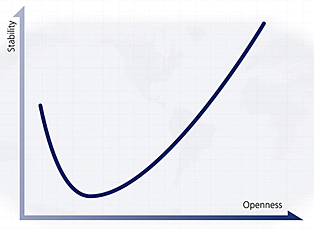
I’ve been out of school for years now but June always elicits an eagerness about the summer and summertime travel. Now if you’re fortunate to find yourself travelling abroad, I hope the only unpleasant part of your trip will be when you’ve got to exchange money. The dollar just ain’t what it used to be.
As many of you know, the US government has been busy buying bonds from banks to jump start the economy. The idea is that banks use this money to lend out. This increases spending and as demand for things increase, prices go up and we have inflation. Now the problem is that when you have inflation, the real value of your dollar goes down and so the dollar “depreciates”, which takes me back to summertime travel and the J-Curve or what I call the “things will get worse, before they get better” curve.
The J-Curve is just that, a graphed curve in the shape of the letter J. In the world of economics, this curve refers to a country’s balance of trade (i.e., does it export more stuff than it imports). As the value of the dollar relative to other currencies falls, it costs more dollars to import that Italian Gucci handbag since the weaker dollar now buys fewer Euros. So in the short run, we find ourselves in the sloping down to the bottom of the J part of the curve. The dollar amount of our imports is higher than our exports and we have a trade deficit. We also can’t believe that the Canadian dollar is worth more than the US!
For US companies that import items to produce their goods, their costs go up. But they may not be able to raise their selling prices as fast, if at all and so profits fall. This is a strong and persistent theme among companies these days. With the dollar being as weak as it is, US companies are crying out in unison – we missed our bottom line because of rising input costs.
However there is hope at the end of the J-Curve tunnel because in the long run, companies should be able to find cheaper suppliers; they should be able to raise their selling prices; and more importantly, the weak dollar should encourage other countries to buy more cheap US goods. Once this happens, we’ll find ourselves on the upward slope of the J, heading higher.
During these down days of the dollar, I really get to see the high quality companies stand out. They are the ones who have “pricing power” – they’ve been able to raise their selling prices to cover rising costs because people still want to buy what they have to sell. I’ve also found great companies on sale because some of their inputs must be imported and in the short run, their profits are getting squeezed.
It’s hard to have faith in the J-Curve when you’re a short term investor. Maybe it feels better to sell now and go away for the summer. If you do and find yourself with fewer Euros than you’d like, just remember you could be making up the difference by investing in great companies that in the long term will ride the J-Curve to profitability once again.




